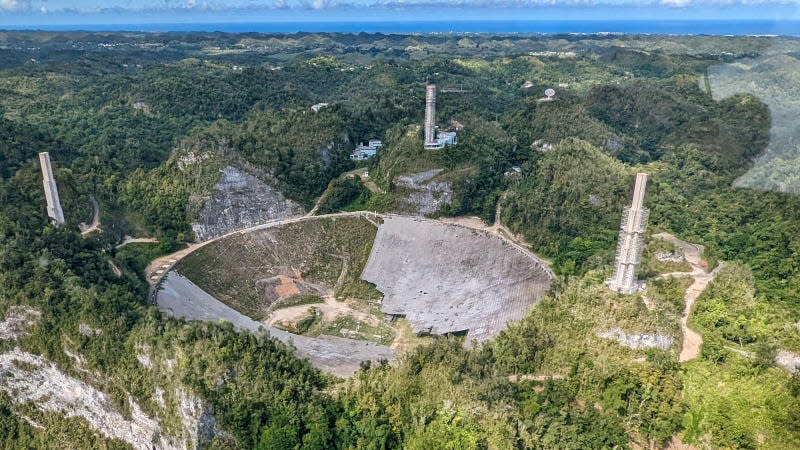Wrecked Arecibo Observatory May Undergo a Downsized Resurrection

It’s been two and a half years since the Arecibo Observatory’s collapse, and the future of the famous radio telescope’s site remains in limbo. Now, observatory astronomers have refined their plans for Arecibo’s successor by reducing the scope of their plans.
The downsizing appears to be a result of lack of funding; even before the telescope’s collapse in December 2020, the National Science Foundation was seeking to reduce its spending on the massive observatory, according to the publication Science.
Read more
The Arecibo Observatory in Puerto Rico was a crucial component of the United States’ radio telescope infrastructure for 57 years, until its collapse. The telescope’s 900-ton instrument platform fell onto the dish due to the failure of support cables, causing tremendous damage to the 1,000-foot telescope. The dramatic collapse was caught on video.
The cables began to fail before the collapse and the NSF had already decided the telescope’s dish would need to be demolished. But the failing infrastructure beat officials to the punch.
Last October, the NSF announced that the site of the destroyed telescope would become a STEM-focused education center slated to open in 2023. It is now 2023, and the foundation is still taking proposals on the education center.
Arecibo Telescope Collapse
Meanwhile, facilities at Arecibo are still operational, besides (obviously) the observatory’s marquee telescope. As reported by PhysicsWorld, earlier this year the NSF announced that the collapsed telescope would be maintained (rather than closed) through September, to allow for a smooth transition into Arecibo’s next form—whatever that might be.
In a paper submitted to the preprint server arXiv last month, a team of astronomers, including Anish Roshi, the head of radio astronomy at Arecibo, proposed that a tiltable array of antennae could form the Next-Generation Arecibo Telescope (NGAT).
Instead of one massive dish (approximately 984 feet across, or 300 meters) the plan describes a cost-effective alternative between 426 feet and 574 feet across (130 meters to 175 meters). The weight of the proposed NGAT is 4,300 tons. The team argues that the proposed telescope’s performance “surpasses all other radar and single dish facilities.”
That’s a big claim, but one that may be needed to make the telescope a reality. When the NSF announced that an education center would replace Arecibo (rather than a new telescope), Sean Jones, the assistant director for directorate of mathematical and physical sciences at NSF, told the AP that the United States had alternative radar facilities that could cover the data footprint vacated by Arecibo.
Whatever takes the place of Arecibo certainly won’t be the same scale as the historic observatory, whose data is still being incorporated in new research. But its successor will somehow fit the goal of scientific pursuit, even if it’s not directly involved in scientific observations.
More: Arecibo Observatory’s Greatest Triumphs
More from Gizmodo
Sign up for Gizmodo's Newsletter. For the latest news, Facebook, Twitter and Instagram.

